阿里
1、SpringBoot与Spring区别
2、Aop应用
3、服务治理
4、微服务划分
5、微服务调用
6、10个线程实现10000个数的相加
// 使用countDownLatch
public class CalculateThread {
private int[] sum = new int[10];
public void calculate(int start, int sumIndex, CountDownLatch countDownLatch) {
for (int i = start; i< start+100; i++) {
sum[sumIndex] += i;
}
countDownLatch.countDown();
}
public int getSum() {
int ret = 0;
for (int i =0; i<sum.length; i++) {
ret+= sum[i];
}
return ret;
}
public static void main(String[] args) {
CountDownLatch countDownLatch = new CountDownLatch(10);
CalculateThread calculateThread = new CalculateThread();
for (int i = 0;i < 10; i++) {
final int j = i;
new Thread(new Runnable() {
@Override
public void run() {
calculateThread.calculate(j * 100, j, countDownLatch);
}
}).start();
}
try {
countDownLatch.await();
} catch (InterruptedException e) {
e.printStackTrace();
}
System.out.println(calculateThread.getSum());
}
}
8、两个不同长度的链表相交,求交点
- A长度为 a, B长度为b, 假设存在交叉点,此时 A到交叉点距离为 c, 而B到交叉点距离为d
- 后续交叉后长度是一样的,那么就是 a-c = b-d -> a+d = b+c
- 这里意味着只要分别让A和B额外多走一遍B和A,那么必然会走到交叉,最后为交叉点为空说明两个没交叉,最后交叉点不为空则说明有交叉

public class Solution {
public ListNode getIntersectionNode(ListNode headA, ListNode headB) {
ListNode currentA = headA;
ListNode currentB = headB;
while (currentA != currentB) {
currentA = currentA == null ? headB : currentA.next;
currentB = currentB == null ? headA : currentB.next;
}
return currentA;
}
}
快手
1、静态内部类和内部类的区别
-
可以对比静态属性和非静态属性来理解
-
内部类
- 内部类可以无条件访问外部类的属性和方法(包括私有的),外部类在访问内部属性和方法时必须先创建一个实例
- 创建内部类实例的时候必须先创建一个外部类实例
- 内部类不能定义static元素和方法,但是允许static final常量
-
static 内部类
- 是内部类的一个特例,一旦内部类被static修饰则该类变成了顶层类,只能访问外部类的静态属性和方法
- 可以直接创建静态内部类的实例
- 可以在内部定义static元素
2、LinkedList的底层实现是啥, ArrayList的底层实现,两者各自优缺点
- linkedList底层实现是双向链表,内部主要维护first和last两个节点,非哨兵节点,插入删除效率高,索引方式查找时会判断index是否大于链表长度的一半,如果大于从后向前找,如果小于从0向后找
- ArrayList底层是一个数组,默认初始化大小是10,当添加元素达到数组现有大小后会按1.5倍来扩容,并拷贝原来的数据
- linkedList插入和删除元素效率很高,只需要修改链表元素的指针即可,而ArrayList需要整体移动元素,效率很低
- ArrayList按索引查询时效率比LinkedList高
3、MySql为什么习惯用自增序列作为主键
innoDB存储引擎在选择聚簇索引时的顺序是这样的:如果有主键选用主键,如果没有选用唯一且非空的字段作为聚簇索引,如果都没有则自己生成一个Row_ID作为聚簇索引,使用自增序列不使用uuid是这样考虑的:
- uuid是一般字符串比较长,比较占用空间
- 自增序列插入效率高:插入数据可以顺序写入;如果不是自增的,则可能导致大量页分裂和页移动,还有可能写入的目标页已经写入到磁盘中而不仅仅是在内存中,又或者目标页还没有被加载到内存中,这样会导致IO操作,效率低下
4、手写一个阻塞队列
// 参考:https://zhuanlan.zhihu.com/p/64156753
public class BlockQueue {
private List<String> dataContainer;
private int size;
private Lock lock = new ReentrantLock();
private Condition condition = lock.newCondition();
public BlockQueue(int size) {
this. size = size;
dataContainer = new LinkedList<>();
}
public void put(String element) {
lock.lock();
try {
while (dataContainer.size() >= size) {
condition.await();
}
dataContainer.add(element);
condition.signalAll();
} catch (InterruptedException e) {
e.printStackTrace();
} finally {
lock.unlock();
}
}
public String pop() {
lock.lock();
String element = null;
try {
while (dataContainer.size() == 0) {
condition.await();
}
element = dataContainer.get(0);
dataContainer.remove(0);
condition.signalAll();
} catch (InterruptedException e) {
e.printStackTrace();
}
finally {
lock.unlock();
}
return element;
}
}
4、谈谈你对泛型的理解
-
泛型即参数化类型, 分为 泛型类、泛型方法、泛型接口, 泛型类型变量不能是基本数据类型,因为擦除后是以Object代替原来的类型T的
-
泛型只在编译阶段有效,编译时先检查代码中泛型的类型,编译之后程序会擦除泛型,泛型信息不会进入到运行时阶段,因此我们可以利用反射来给我们定义好的list添加任意类型的元素
public static void main(String args[]) throws NoSuchMethodException, InvocationTargetException, IllegalAccessException { ArrayList<Integer> array=new ArrayList<Integer>(); // 这样调用add方法只能存储整形,因为泛型类型的实例为Integer array.add(1); // 通过泛型可以突破泛型类型约束 array.getClass().getMethod("add", Object.class).invoke(array, "asd"); for (int i=0;i<array.size();i++) { System.out.println(array.get(i)); // 如果这里这样定义, 会报类型转换的错误,编译器在这里自动插入int的强制类型转换 // int a = array.get(i); } // 这段代码不会报任何的错 } -
PECS原则(Producer Extends Consumer Super)
- 频繁往外读取内容的,适合用上界Extends。
- 经常往里插入的,适合用下界Super。
-
参考文章:
- https://blog.csdn.net/sunxianghuang/article/details/51982979
- https://segmentfault.com/a/1190000005179142